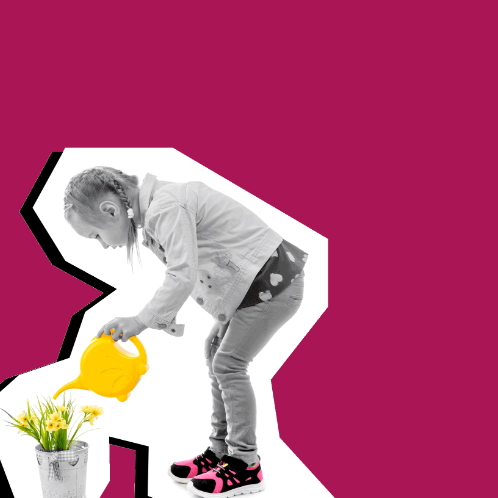...Or if you’re no Bear Grylls, the garden will suffice.
Ever the optimists, as summer nears we’d like to raise two points of caution. One, this is Britain and sunshine is far from guaranteed. And two, little ones can encounter serious danger if the garden isn’t swept for risks.
Over 125,000 children are injured, and worse, in UK garden accidents each year. Assuming you’re like every other parent - human, fallible and physically unable to keep watch every second of every hour - it pays back in peace-of-mind if you get in there first.
So here’s a quick and easy guide to spot risks alongside some hacks, tips and tricks to kiddy-proof the garden. And ensure everyone - especially the parents - can enjoy a famous summer.
1. A fun little prison
Let’s start with the perimeter. First, is your garden contained? Can children escape or is it a fun little prison? We’re aiming for the latter. No-one wants to hear the squeak of tyres on tarmac because a little someone broke loose.
If your garden’s the type of garden that’s open onto roads on all sides then this part’s not going to work for you. Skip to Point 3. - creating a safe zone maybe the best way to go.
For those who have hedges, check for any child-sized gaps while remembering that kids are small, nimble and love a challenge. To complete the fortress, run chicken wire over holes, and down the base if you’re worried about a tunnel-job. If an over-the-fence escape concerns you then … well, maybe this is an indoor summer. Thoughts?
How about the latch on the gate; the one that’s broken and you’ve been meaning to fix? Now’s the time. Nip to the shop, pick up a new one and fit it yourself. Some DIY 101 to start the summer months.
2. Flora, fauna, oh flip!
The hedges we spoke about earlier? Make sure they’re trimmed down and ship shape. That might mean breaking out the clippers and chopping anything thorny or prickly. Because what’s safely knee height for you and me is perfect scalp-and-eye level for little Mr and Mrs.
Now, who’d have thought flowers could be an issue? Well, they can be so it’s worth scouting out the prickly ones - and the toxic ones.
The likes of oleander, lilies, azaleas and foxgloves pose a danger if ingested. Even rhubarb - its leaves can poison if eaten. Spend some time identifying whether your roses, holly, nettles etc pose a risk. Then decide if their aesthetic beauty trumps the potential for blood and tears.
The bottom line, as we all know, is that kids are curious, they want to look and touch. So minimising risk might mean compromise - perhaps even floral sacrifice.
3. Safe place within a safe place
Without getting too inception on you, why not create a safe area within your safe area? Sure, we want an entirely child-friendly garden, but that’s not always possible. So establishing a base for the kids to spend the majority of time is a way to limit exposure to big ticket risk factors elsewhere.
But that’s not to say you go all clinical on it. Why not brand-up the safe area as a special adult free zone arranged around a centrepiece: a new sandbox or wendy house. Dare we say, even a paddling pool. These can all help sell-in the idea of a safe area without it looking like a calculated parental move. And if the safe zone’s a big hit, the juniors are less likely to want to roam towards shiny or sharp things.
Speaking of which, is the garage or shed locked? Is that where all the sharp tools and garden chemicals in brightly coloured bottles are kept? Yeah, let’s double check it’s locked.
If we do go with a paddling pool, it’s vital to hide the hose and shut off the outside water properly, tightly. Childproof that thing! And on the paddling pool itself - empty after every use. Even a couple of inches of water is enough … you know this part.
4. Slips and smashes - be wary of gashes
Grass areas, safe-zones, barricades, bolts, locks etc, you’ve covered those - now comes the rest.
Thinking about trips and bumps: anything lying around or within reach? Aim to fill in big divots and remove the clothes whirly out when not-in-use. At kiddie-head-height, are there clotheslines, bird feeders or low-hanging branches? You know what to do. Anything the kiddiewinkles can fall off or down or onto or … yes, see to those too.
It may also be worth doing a sweep to spot nails or debris or even shards of glass from barbecues or wild parties in days gone. Nasties may be lurking at soil level so checking thoroughly might save you a trip to A&E.
Speaking of glass - where are the windows in all this? Any greenhouses, glass-sheeting or single-pane patio doors around? These are, fairly obviously, a big red flag and need to be removed, blocked off, or barricaded.
And with its gaps and grooves, raised decking can be another trip trap. If the young ones fall on solid wood then you’ll hear about it. No doubt. Why not stick some soft garden furniture down to break a fall, or at the very least reduce the size of the play area.
Also, given the unpredictable British climate, a spot of rain can turn a deck into a roller rink. For that, a fresh coat of non-slip paint is just the ticket. That’s DIY 102.
5. Relax and pray for sun
Of course the list could go on and on, getting more paranoid, absurd and outlandish trying to predict what and how your little one’s at risk.
But it’s impossible to think either we or you can neutralise every threat.
So once you’ve done what you can, you’ve held up your end. Relax.
Over to you, chaos.
Brought to you by our partner, LifeSearch



